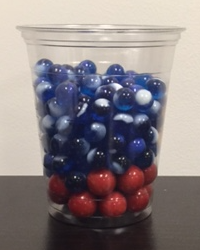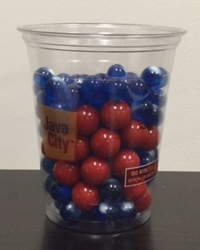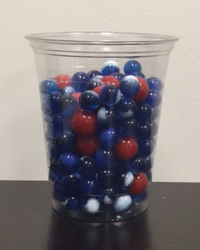Research
What is the Brazil Nut Effect?
The Brazil Nut Effect is best illustrated by an example. Take marbles of two different sizes and put the bigger ones at the bottom of a clear container (the red marbles in the picture are bigger than the blue ones). As you shake the container vertically, you will notice that the larger marbles will gradually rise to the top. This is know as the Brazil Nut Effect. The name comes from the observation that in a can of mixed nuts, the larger Brazil Nuts seem to usually be found at the top. This effect is studied in a number of contexts. For example, pharmaceutical companies need to ensure this size sorting does not affect the consistency of medicines. Also, the Brazil Nut Effect may influence the surface of asteroids.
Brazil Nut Effect on Asteroids
Many asteroids are considered to be rubble-piles in that they are a collection of objects held together largely by their self-gravity. As such asteroids likely behave like granular material. Granular material, like sand, can act both like a solid (you can make a pile of sand) and a liquid (sand flows inside an hourglass). Take a look at the image of asteroid Itokawa. Notice how it visually seems to be a collection of particles? There are other reasons to suspect that asteroids are rubble-piles (e.g., they seem to have a limited spin rate).
Using a discrete element modeling computer code called pkdgrav, I modeled an asteroid as a three-dimensional collection of smaller objects. The video shows an asteroid-like object that has an overall radius of about 800 meters and is made of large red balls (80 meters in radius) and small yellow balls (40 meters in radius). Though not exactly like a real asteroid, the end product is similar to an asteroid in that it is made of a collection of smaller objects and thus allows me to study both surface and internal properties of asteroids. Of course real asteroids are not that spherical and are not made of smaller perfect spherical objects. However, to make these simulations more realistic the pkdgrav code not only incorporates gravity, but also friction (which is important since a ball rolling on a surface will not roll forever) and loss of energy due to collisions (since a ball that is dropped on the floor will not keep bouncing forever). The addition of certain physical aspects to these simulations make them more realistic.
In the video every time you see a jolt it is because at that moment each particle was assigned a random velocity (both a random speed and a random direction). That was done to mimic impacts onto this modeled asteroid. As asteroids are shaken by impacts, they should size sort with larger objects rising to the surface while smaller objects sink toward the center. One of the findings of our work is that while asteroids may be size-sorted near their surfaces, their interiors are unlikely to be size-sorted.
Image of asteroid Itokawa (Credit: JAXA). Notice that the surface has many large boulders. The one on the right seems to be just sitting there.
A computer simulation of a rubble-pile asteroid experiencing repeated shaking due to impacts and undergoing size-sorting of constituent particles (i.e. the Brazil Nut Effect).
What is Discrete Element Modeling?
Discrete Element Modeling (DEM) is a type of computer program that models particles interacting with each other under the influence of forces such as gravity. There are many DEM codes but pkdgrav is one of the widely used codes in planetary science. Particles modeled in pkdgrav can have self-gravity, has some elasticity, and are affected by friction. Below are several example to demonstrate the capabilities of pkdgrav.
A simple simulation showing how particles will fall towards the center of mass under self-gravity. All particles are of the same size but are colored for clarity.
A simple simulation showing how particles will fall towards the center of mass under self-gravity. One of the particles is bigger and since the density of all the particles are the same, that bigger particle is also more massive than any of the smaller particles. As can be seen, the more massive particle largely dictates the location of the center of mass and as such the other particles seem to fall towards the more massive particle.
In this simulation a rupple-pile asteroid is being spun up. You should notice that because of the spin, the asteroid bulges out at the equator much like the Earth.
This simulation demonstrates the fact that modeling isn’t perfect and things can go wrong if you are not careful about the parameters you choose.
This is quite literally a particles-in-a-box simulation using pkdgrav. The box is divided into three chambers and particles must stay within their respective chamber. You will notice that the smaller particles will fall towards the larger (massive) particle due to self-gravity.
This simulation is similar to the previous one except that the smaller particles start off with some initial speed. Thus, the particles take longer to settle here.
Interested in teaching this to students?
Please click on the button for my PowerPoint slides. You are welcome to use, edit, and improve them.



